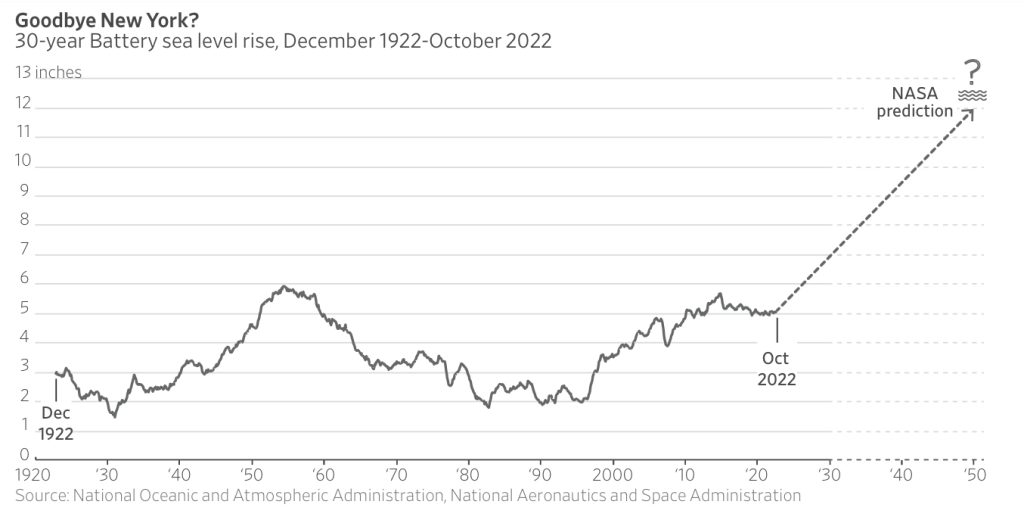The Battery’s sea level hasn’t done anything in recent decades that it hasn’t done over the past century
By Steven E. Koonin, Wall Street Journal, Jan. 5, 2023
A recent National Aeronautics and Space Administration report yet again raises alarm that New Yorkers are about to be inundated by rapidly rising seas. But a review of the data suggests that such warnings need to be taken with more than a few grains of sea salt.
The record of sea level measured at the southern tip of Manhattan, known as the Battery, begins in 1856. It shows that today’s waters are 19 inches higher than they were 166 years ago, rising an average of 3.5 inches every 30 years. The geologic record shows that this rise began some 20,000 years ago as the last great glaciers melted, causing the New York coastline to move inland more than 50 miles.
There is no question that sea level at the Battery will continue to rise in coming decades, if only because the land has been steadily sinking about 2 inches every 30 years because of factors including tectonic motion, rebound from the mass of the glaciers, and local subsidence. Rather, the question is whether growing human influences on the climate will cause sea level to rise more rapidly. To judge that, we can compare recent rates of rise with those in the past, when human influences were much smaller.
The chart below shows how much sea level rose during the 30 years prior to each year since 1920. That rise has varied between 1.5 and 6 inches. The 5-inch rise over the most recent 30 years is higher than the century-long average but isn’t unprecedented and shows no sign of increasing.

As the Earth warms, changes in sea level at the Battery will depend in part on global changes. These include the loss of ice from mountain glaciers, Greenland and Antarctica as well as the ocean’s expansion as it warms. It’s very difficult to predict these changes—many factors influence ice loss, and the oceans absorb only 0.25% of the heat flowing through the Earth’s climate system. The 30-year rises in the latter half of the 20th century were diminished by about an inch due to the filling of reservoirs behind dams and changes in groundwater around the world.
The Battery’s sea level also depends on local changes in the sea and the sinking of the land. Most important is the natural variability of winds, currents such as the Gulf Stream, salinity and temperatures of the North Atlantic, which cause variations in sea level along the entire U.S. Northeast coast. Because of these many variables, climate models can’t account for the ups and downs so evident in the graph.
NOAA prediction would double sea-level rise over 30 years
Despite this, the recent NASA report echoes a February National Oceanic and Atmospheric Administration report predicting more than 1 foot of rise at the Battery by 2050. Such a rise during the coming 30 years would be more than double the rise over the past 30 years and more than triple the past century’s average. Even more remarkably, the NOAA report says this rise will happen regardless of future greenhouse-gas emissions. There is no way of knowing if this prediction is correct.
So while New Yorkers should watch the waters around them, there is no need to dash to higher ground. The Battery’s sea level hasn’t done anything in recent decades that it hasn’t done over the past century. And although we’ll have to wait three decades to test the predicted 1-foot rise, measurements over the next decade should tell us how quickly we’ll need to raise the sea walls.
Steven Koonin is a professor at New York University, a senior fellow at Stanford’s Hoover Institution, and author of “Unsettled: What Climate Science Tells Us, What It Doesn’t, and Why It Matters.”
